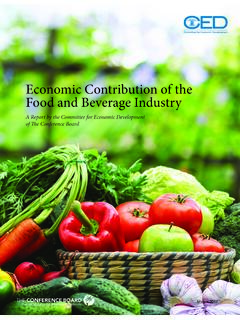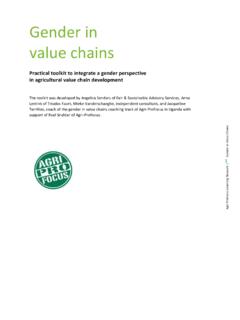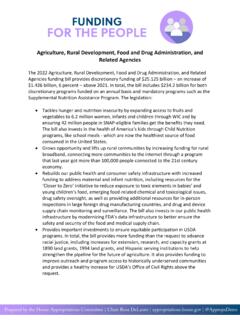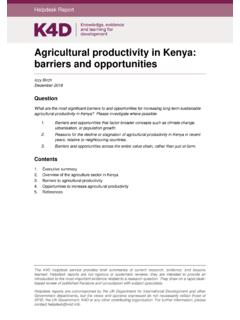Transcription of Economic Contribution of the Food and Beverage Industry
1 March 2017 Economic Contribution of the food and Beverage Industry A Report by the Committee for Economic Development of The Conference Board Economic Contribution of the food and Beverage Industry2 About the Committee for Economic Development The Committee for Economic Development of The Conference Board (CED) is a nonprofit, nonpartisan, business-led public policy organization that delivers well-researched analysis and reasoned solutions to our nation s most critical its inception in 1942, CED has addressed national priorities to promote sustained Economic growth and development to benefit all Americans. CED s work in those first few years led to significant policy accomplishments, including the Marshall Plan, the Economic development program that helped rebuild Europe and maintain the peace; and the Bretton Woods Agreement that established the new global financial system and both the World Bank and International Monetary , CED continues to play an important role through its trusted research and advocacy.
2 Composed of leading business executives, CED lends its voice and expertise on pressing policy issues. In recent decades, CED has made significant contributions across a broad portfolio, including pre-K education importance and funding, bipartisan campaign reform, corporate governance reform, US fiscal health, academic standards in K-12 education, postsecondary education access and achievement, the importance of STEM education, immigration, free trade, foreign assistance, women on corporate boards, Medicare and broader healthcare reform, crony capitalism, inequality, judicial selection reform, child care, the role of business in promoting educational attainment, digital learning, teacher compensation and quality, corporate short-termism, federal tax reform, social security.
3 Innovation and growth, reducing global poverty, welfare reform, and s work is based on seven core principles: sustainable capitalism, long-term Economic growth, efficient fiscal and regulatory policy, competitive and open markets, a globally competitive workforce, equal Economic opportunity, and nonpartisanship in the nation s interest. CED s research findings are disseminated widely, achieving tangible impact at the local, state, and national ReportEconomic Contribution of the food and Beverage Industryby Laurian Unnevehr, Professor Emerita, Agricultural and Consumer Economics, University of Illinois at Urbana-Champaign; commissioned by the Committee for Economic Development of The Conference BoardContents 5 Executive Summary 5 Providing a stable source of employment 5 Playing an important role in local economies 6 Contributing to innovation in the food system 6 Responding to increased demand for US exports 6 Contributing to food affordability 7 Addressing increasingly sophisticated consumer demand 7 Meeting societal goals.
4 Public policy and the Industry s role 8 Looking to the future 9 Introduction 11 Market Environment for the food and Beverage Industry 11 Background and Economic History 12 The food and Beverage Industry in the food value chain 19 food Consumer Expenditures and food Demand 22 Economic Footprint of the food and Beverage Industry 22 Firms, Employees, and Locations in the food System 28 Direct Economic Activity Associated with the food and Beverage Industry 30 Economic Multiplier Impacts from the food and Beverage Industry in Local Communities 34 food and Beverage Industry Innovation and Research 37 Public Policy and the food and Beverage Industry 37 The food and Beverage Industry s Contribution to Society and National Goals 39 Government Programs and the food and Beverage Industry 41 Government Regulations and the food and Beverage Industry 44 Concluding Comments Economic Contribution of the food and Beverage Industry4 AcknowledgmentsThis report was supported by Diane Lim, Principal Economist, The Conference Board.
5 And Caroline DeLancey, Foundation Relations Manager, Committee for Economic Development. Research assistance was provided by Chau Nguyen and Alexandra Mosenson. The report benefited from guidance provided by a working group of food Industry ReportExecutive SummaryThe food sector plays an essential role in the US economy, accounting for about 5 percent of gross domestic product, 10 percent of total US employment, and 10 percent of US consumers disposable personal income (DPI). The food sector has total sales of $ trillion, including food consumed at home and away from deliver food to consumers, a complex food value chain extends from farm producers to food consumers and includes production, processing, packaging, storage, transportation, and retail sales.
6 This report focuses on the food and Beverage Industry within the food value chain . This Industry transforms raw farm commodities from over 2 million farms into consumer food and Beverage products marketed through nearly 680,000 retail stores and foodservice outlets. The food and Beverage Industry meets the continuous needs of 320 million American consumers, as well as many consumers overseas, by managing food supplies from widely dispersed farms that often produce only once a year. The food and Beverage Industry coordinates with farm producers and other actors in the food value chain to provide the product quality that consumers demand. Thus, it provides the primary link between farm production and food report examines the role of the food and Beverage Industry within the food system and in regional economies; how the food and Beverage Industry contributes to growth and innovation in the food system; how the food and Beverage Industry responds to emerging and dynamic consumer demand; and the role of public policy in shaping the market environment for the food a stable source of employment Of the total $ trillion in food sector sales, the food and Beverage Industry alone generates $164 billion in value added and accounts for cents out of every consumer food dollar.
7 This value added is paid out in $83 billion in total salary and benefits (which includes pretax employee wages plus employer and employee costs for employee benefits), $10 billion in taxes, $62 billion in property income, and $9 billion for imported inputs. food manufacturing tends to have relatively high payments to salaries and benefits compared with other food sector industries. Salaries and benefits account for half of the value added in food food and Beverage Industry has nearly 27,000 establishments employing million workers and accounts for about 13 percent of all US manufacturing employment and about 1 percent of all US nonfarm employment. The Industry is dominated by bakeries and tortilla manufacturing (39 percent of establishments and 18 percent of employees) and by animal slaughter and processing (14 percent of establishments and 33 percent of employees).
8 The food and Beverage Industry has been more stable in terms of employment and labor income than other manufacturing industries in the United States, due to the consistent demand for food and the competitive prices of raw an important role in local economiesThe food and Beverage Industry is present in every state and often provides a major Contribution to the state s economy. The states with the greatest total numbers of employees in the food and Beverage Industry are, in descending order: California, Texas, Illinois, Pennsylvania, Wisconsin, Georgia, Ohio, Iowa, North Carolina, New York, Minnesota, Arkansas, and Missouri. Economic Contribution of the food and Beverage Industry6 food and Beverage Industry employment as a share of employment reveals the relative importance of this Industry in some states with smaller populations.
9 The food and Beverage Industry accounts for more than 20 percent of all manufacturing employment in Hawaii, Nebraska, Delaware, Idaho, Iowa, and South Dakota. The states where food and Beverage Industry employment is 2 percent or more of total nonfarm employment are: Nebraska, Iowa, Idaho, Wisconsin, South Dakota, and Kansas. The relatively labor-intensive nature of food processing leads to strong Economic multiplier impacts on local economies. In seven different states, recent studies show that every dollar of food and Beverage Industry output generates between $ and $ of additional Economic activity. Every job in the food and Beverage Industry generates between one and three additional jobs in local and regional economies as employees spend their wages on local goods and services.
10 At the national level, Economic multiplier impacts are larger, as these indirect impacts ripple through the economy. One study estimates that US food manufacturing generates over $ of additional value added in the economy for each dollar of value added in the Industry and five additional jobs for every Industry to innovation in the food systemThe food and Beverage Industry innovates to add value and to meet evolving consumer demand at home and abroad. food Industry research expenditures have nearly doubled during the past decade, and the US Industry spends $ billion annually on research or 3 percent of Industry value added. Venture capital firms invest another $3 billion to fund innovations in food market and processing food and Beverage Industry has responded to the dynamics of consumer demand and food retailing by introducing new product offerings that meet growing demands from consumers for healthfulness and quality.








